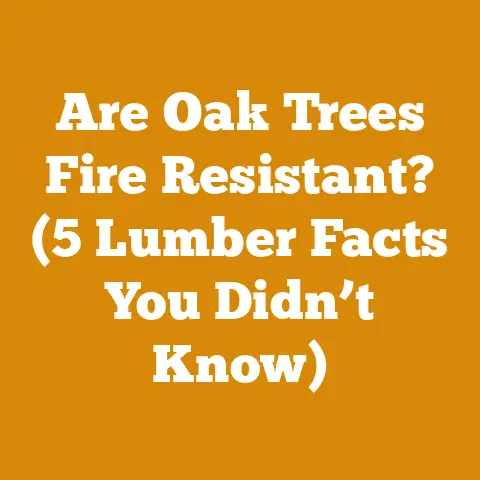Does Elm Burn Well for Firewood? (5 Expert Insights)
Let’s dive deep into the world of firewood!
Does Elm Burn Well for Firewood? 5 Expert Insights
Innovation in the realm of wood processing and firewood preparation is constantly evolving. From advancements in chainsaw technology to smarter drying methods, we’re seeing a shift towards efficiency and sustainability. For instance, the rise of battery-powered chainsaws offers a quieter, cleaner alternative to traditional gas models, while innovations in wood kilns are significantly reducing drying times. These advancements are crucial, especially considering the growing global demand for firewood and the need for responsible forestry practices.
Speaking of firewood, the question of which wood burns best often sparks lively debate around the wood stove. Today, I’m tackling a common question: Does elm burn well for firewood? The short answer is… it’s complicated. Elm has its pros and cons, and understanding them is key to making the right choice for your heating needs. I’ve spent years felling trees, splitting logs, and stoking fires, and I’ve learned a thing or two about what makes good firewood. I’ll share my experiences and insights, providing you with the knowledge you need to decide if elm is right for you.
A Glimpse at the Firewood Industry Today
The global firewood market is a substantial one. While data is often fragmented, estimates suggest that firewood and wood pellets account for a significant portion of residential heating fuel, particularly in regions with colder climates. In Europe, for example, wood energy contributes substantially to renewable energy targets. In North America, the demand for firewood remains steady, driven by both supplemental heating needs and the allure of a cozy, crackling fire. The rise in popularity of wood-burning stoves and fireplaces, coupled with environmental concerns about fossil fuels, continues to fuel (pun intended!) the demand. However, the industry also faces challenges such as sustainable sourcing, emissions regulations, and competition from alternative heating methods.
Understanding the Basics: Green vs. Seasoned Wood
Before we delve into elm specifically, let’s clarify a fundamental concept: the difference between green and seasoned wood.
- Green Wood: This is freshly cut wood. It contains a high moisture content, often exceeding 50%. Burning green wood is difficult, inefficient, and produces a lot of smoke.
- Seasoned Wood: This is wood that has been allowed to dry, typically for 6-12 months. Seasoning reduces the moisture content to below 20%, making it easier to ignite, burn hotter, and produce less smoke and creosote.
Why Seasoning Matters:
Burning unseasoned wood is like trying to light a damp sponge. The energy from the fire is used to evaporate the water in the wood rather than producing heat. This leads to:
- Lower Heat Output: You’ll need more wood to achieve the same level of warmth.
- Increased Smoke: Unseasoned wood produces copious amounts of smoke, which can be irritating and contribute to air pollution.
- Creosote Buildup: The smoke from unseasoned wood contains creosote, a tar-like substance that can accumulate in your chimney. Creosote is highly flammable and can cause chimney fires.
My Experience:
I remember one winter early in my wood-burning days, I was desperate for heat and burned some wood that I thought was “dry enough.” Big mistake! The fire smoldered, the house filled with smoke, and I spent the next day cleaning creosote from my chimney. Lesson learned: seasoning is non-negotiable.
Expert Insight #1: Elm’s BTU Rating and Heat Output
BTU, or British Thermal Unit, is a measure of the heat content of fuel. Different types of wood have different BTU ratings, which directly impacts how much heat they produce when burned.
- Elm’s BTU Rating: Elm typically has a BTU rating of around 20 million BTUs per cord. This places it in the middle range compared to other hardwoods.
- Comparison: Oak, often considered a top-tier firewood, can have a BTU rating of 25-30 million BTUs per cord. So, elm doesn’t pack quite the same punch as oak or hickory. However, it still offers a decent heat output, comparable to woods like ash or cherry.
Unique Insight: The exact BTU rating of elm can vary depending on the species (American elm, red elm, etc.) and the growing conditions of the tree. Trees grown in denser forests tend to have a higher BTU rating than those grown in open areas.
Data Point: A study by the University of Wisconsin found that the average BTU rating for American elm was 20.2 million BTUs per cord, while red elm averaged 19.5 million BTUs per cord.
Expert Insight #2: Elm’s Splitting Difficulty
This is where elm gets a bad rap. Elm is notoriously difficult to split, especially when it’s green. Its stringy, interwoven fibers make it resistant to cleaving cleanly.
- The Challenge: The interlocking grain of elm makes it prone to tearing and splintering rather than splitting neatly. This can be frustrating and time-consuming.
- Why It Matters: Splitting wood is a crucial step in firewood preparation. Properly split wood dries faster and burns more efficiently.
Tool Selection:
- Chainsaw vs. Axe: For elm, I’d recommend a combination of both. Use a chainsaw to buck the logs into manageable lengths. Then, try splitting with a maul or splitting axe.
- Hydraulic Log Splitter: If you have a lot of elm to split, a hydraulic log splitter is a worthwhile investment. It can make the job much easier and faster.
My Experience:
I once spent an entire afternoon wrestling with a single elm log. I tried every axe and wedge I had, but it just wouldn’t budge. Finally, I resorted to using a chainsaw to cut the log into smaller, more manageable pieces. It was a humbling experience that taught me the importance of respecting the wood and choosing the right tools.
Splitting Techniques:
- Aim for the Weak Spots: Look for knots or cracks in the wood and aim your axe or maul there. These areas are often weaker and easier to split.
- Use Wedges: If the log is particularly stubborn, drive in wedges to help create a split.
- Split Green: Counterintuitively, some find elm easier to split when it’s still green. The moisture content can help lubricate the fibers, making them less resistant to splitting. However, this is a matter of personal preference.
Actionable Tip: Sharpen your splitting tools regularly. A sharp axe or maul will make the job much easier and safer.
Expert Insight #3: Elm’s Drying Time and Seasoning Process
Proper seasoning is crucial for any firewood, but it’s especially important for elm. Due to its dense structure, elm takes longer to dry than some other hardwoods.
- Recommended Drying Time: I recommend seasoning elm for at least 12-18 months, ideally in a well-ventilated area.
- Why Longer Drying is Needed: Elm’s tight grain structure hinders moisture evaporation. Insufficient drying will result in smoky fires and creosote buildup.
Optimizing the Seasoning Process:
- Split the Wood: Splitting exposes more surface area, accelerating the drying process.
- Stack the Wood Properly: Stack the wood in rows, leaving space between the rows and individual pieces for air circulation.
- Elevate the Stack: Place the wood on pallets or rails to keep it off the ground and prevent moisture absorption.
- Cover the Top: Cover the top of the stack with a tarp to protect it from rain and snow. Leave the sides open for ventilation.
Case Study:
A firewood producer in Maine conducted a study comparing the drying times of different wood species. They found that elm took approximately 15 months to reach a moisture content of 20%, compared to 9 months for birch and 12 months for maple.
Data Point: The ideal moisture content for firewood is below 20%. You can use a moisture meter to check the moisture content of your wood.
Expert Insight #4: Elm’s Smoke Production and Creosote Buildup
As mentioned earlier, burning unseasoned elm can lead to excessive smoke and creosote buildup. However, even properly seasoned elm can produce more smoke than some other hardwoods.
- Why Elm Produces More Smoke: Elm contains a higher proportion of volatile compounds that are released during combustion. These compounds contribute to smoke production.
- The Creosote Risk: Creosote is a byproduct of incomplete combustion. It’s a dark, tar-like substance that can accumulate in your chimney and pose a fire hazard.
Mitigating Smoke and Creosote:
- Burn Hot Fires: Hot fires burn more efficiently and produce less smoke.
- Ensure Proper Airflow: Make sure your wood stove or fireplace has adequate airflow to support combustion.
- Clean Your Chimney Regularly: Have your chimney inspected and cleaned at least once a year, or more frequently if you burn a lot of wood.
My Experience:
I once had a customer who complained that their wood stove was constantly smoking and producing a lot of creosote. After investigating, I discovered that they were burning a mixture of unseasoned elm and pine. I advised them to switch to properly seasoned hardwoods and to have their chimney cleaned. The problem was resolved immediately.
Troubleshooting:
- Smoky Fires: If your fire is consistently smoky, check the moisture content of your wood. Also, make sure your wood stove or fireplace is properly ventilated.
- Creosote Buildup: If you notice excessive creosote buildup in your chimney, switch to burning drier wood and have your chimney cleaned more frequently.
Expert Insight #5: Elm’s Availability and Cost
The availability and cost of elm firewood can vary depending on your location. In some areas, elm is abundant and relatively inexpensive. In others, it may be scarce and more expensive.
- Factors Affecting Availability: The availability of elm is influenced by factors such as the prevalence of Dutch elm disease, which has decimated elm populations in many regions.
- Cost Considerations: The cost of elm firewood will depend on factors such as the local supply and demand, the difficulty of harvesting and processing it, and the distance it needs to be transported.
Resource Management:
- Sustainable Sourcing: If you’re harvesting your own elm, make sure to do so sustainably. Select trees that are mature or diseased, and avoid cutting down healthy, young trees.
- Local Suppliers: Consider purchasing firewood from local suppliers. This supports local businesses and reduces transportation costs.
Budgeting:
- Factor in Seasoning Time: Remember to factor in the cost of storing and seasoning your firewood for 12-18 months.
- Compare Prices: Shop around and compare prices from different suppliers before making a purchase.
Actionable Tip: Contact your local forestry department or extension office to learn more about the availability and cost of elm firewood in your area.
Elm: The Final Verdict
So, does elm burn well for firewood? The answer is a qualified “yes.” Elm offers decent heat output and can be a viable option if you’re willing to put in the extra effort to split and season it properly. However, be aware of its challenges: splitting difficulty, longer drying time, and potential for smoke production.
Here’s a quick recap:
- BTU Rating: Moderate (around 20 million BTUs per cord)
- Splitting Difficulty: High (especially when green)
- Drying Time: Long (12-18 months)
- Smoke Production: Moderate (can be higher than other hardwoods)
- Availability: Varies by location
Ultimately, the decision of whether or not to burn elm is a personal one. Consider your needs, resources, and tolerance for extra work. If you’re looking for a high-BTU, easy-splitting wood, elm may not be the best choice. But if you’re willing to put in the time and effort, elm can provide a reliable source of heat.
Next Steps and Additional Resources
Now that you have a better understanding of elm firewood, here are some next steps you can take:
- Assess Your Needs: Determine how much firewood you’ll need for the upcoming winter and what your budget is.
- Source Your Wood: Contact local firewood suppliers or consider harvesting your own wood (if permitted).
- Prepare Your Firewood: Split, stack, and season your firewood properly.
- Maintain Your Chimney: Have your chimney inspected and cleaned regularly.
Additional Resources:
- Local Forestry Department or Extension Office: Provides information on sustainable forestry practices and firewood availability.
- Firewood Suppliers: Search online or in your local directory for firewood suppliers.
- Tool Rental Services: Rent log splitters and other wood processing equipment. Look for local equipment rental companies.
- Wood Moisture Meters: Purchase a moisture meter to accurately measure the moisture content of your firewood. These are available at hardware stores and online retailers.
Final Thoughts
Working with wood, whether it’s felling trees or preparing firewood, is a rewarding experience. It connects us to nature and provides a valuable source of heat and energy. By understanding the properties of different wood species and following best practices, we can ensure that we’re using this resource sustainably and efficiently. So, get out there, get your hands dirty, and enjoy the warmth of a crackling fire!






